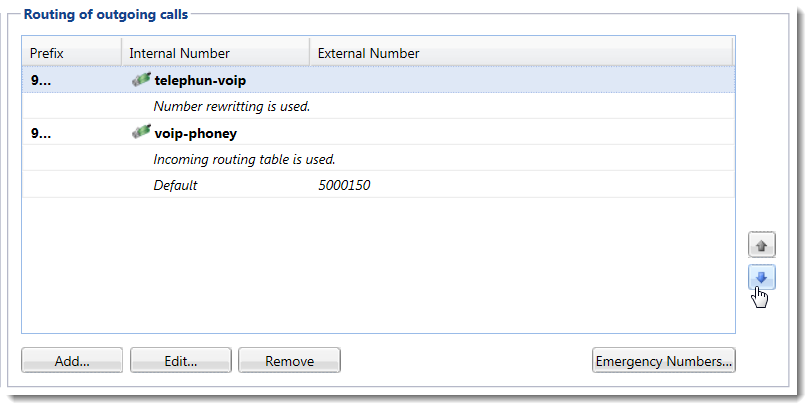Mapping external and internal numbers
In Kerio Operator you can map external numbers to internal extensions. You can:
- Strip the first
0-ndigits from the number, including reducing the number to an empty string - Add other digits to the beginning of the number
Routing incoming calls
In Kerio Operator, you can use rewriting rules to map numbers for SIPSession Initiation Protocol - A communication protocol used for voice and video calls in Internet telephony or private IP telephone systems. and standard phone interfaces. Depending on your provider's requirements, you may need to strip out or change numbers
Example:
- A company has 100 phone numbers from a telephone provider.
- For incoming calls, the provider sends the whole number.
- For outgoing calls, the provider requires the whole number.
- Internal extensions have the format
2xx. - The prefixCountry codes, area codes, a number, or a set of numbers that are dialed before the telephone numbers. for outgoing calls is
9.
When external Phone A (with the number 5550399) calls internal Phone B (with the number 5550101 and the internal extension 201):
- Phone A dials Phone B's number and a signal goes to the provider.
- The provider sends the number to Kerio Operator.
- The rewriting rule strips five digits from the left and adds the prefix
2. - The call connects.

Mapping a trunk of numbers
To set the interface for an interval of numbers (55501xx in this example):
- In the administration interface, go to Configuration > Call Routing > Interfaces and routing of outgoing calls.
- Select the routing rule for the provider interface and click Edit. The Edit Incoming Call dialog box opens.
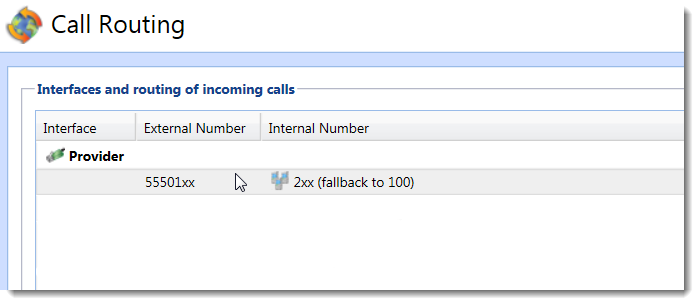
- In the Called number section,
strip the first five digits from the left, and add the prefix
2. This modifies the number to the final format of the extension (2xx). - In the Calling number section, do not strip out any digits, and add the prefix
9. This is useful when you want to call back the external number. - Click OK.

Mapping a single number or multiple numbers
To set the interface for single or multiple numbers (5550100 to 5550199 in this example):
- In the administration interface, go to Configuration > Call Routing > Interfaces and routing of incoming calls.
- Select the routing rule for the provider interface and click Edit. The Edit Incoming Call dialog box opens.
- Double-click a line in the Extension column and assign an extension to the external number.
- In the Called number section,
strip the first two digits from the left, and add the prefix
2. This modifies the number to the final format of the extension (2xx). - Click OK.

Routing outgoing calls
You can configure outgoing calls when creating an interface, either SIP or hardware cards.
For rewriting the numbers, you need additional configuration.
Example:
- External Phone A has the number 5550199.
- Internal Phone B has the number 5550101 and the internal extension 201.
- For outgoing calls, Kerio Operator uses the prefix 9.
- The provider needs the whole number for outgoing calls.

When Phone B calls Phone A:
- Phone B dials the number with the 9 prefix (95550199).
- Kerio Operator uses rewriting rules and strips out the first digit (9). The number Kerio Operator sends to the provider is 5550199.
- The provider connects to Phone A.
To achieve this configuration:
- In the administration interface, go to Configuration > Call Routing > Routing of outgoing calls.
- Select an interface and click Edit. The Edit Outgoing Route dialog box opens.
- In the Called number section, strip one digit from left and do not add a prefix.
- Click OK.
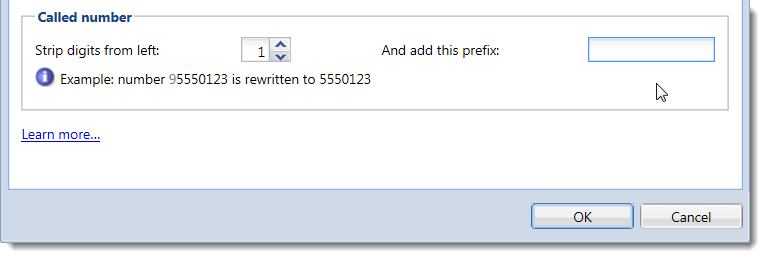
Rules for outgoing calls
You can configure rules for outgoing calls:
- In the administration interface, go to Configuration > Call Routing > Routing of outgoing calls.
- Select an interface and click Edit.
- In the Calling number (Caller IDA service that provides information about caller's number.) section, select one of these options:
- Map extensions to external numbers based on routing of incoming calls if you want to use a table of external numbers configured for the provider
- Assign the default number to all extensions if you want to use a default number for all extensions
- Rewrite extension numbers (default number not used) if you want to rewrite numbers in a specific way
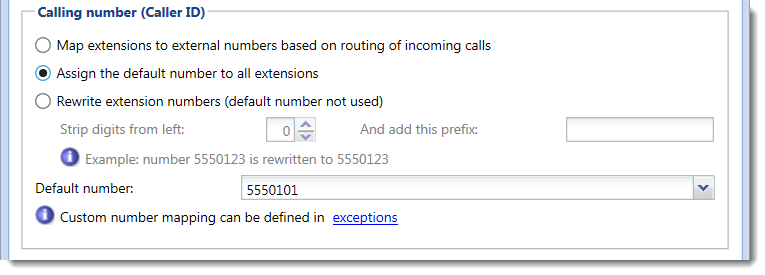
Exceptions to the outgoing routes
To create an exception:
- In the administration interface, go to Configuration > Call Routing > Routing of outgoing calls.
- Select an interface and click Edit.
- Enable the Use route only for numbers defined in exceptions option.
- Click the Exceptions tab and click Add.
- To change the internal number, double-click the displayed extension and select a new extension.
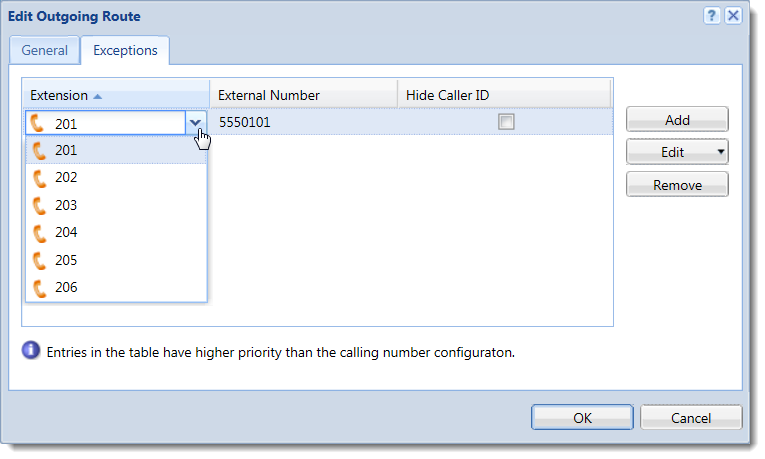
- To change the external number, double-click the displayed number and select a new number.
- If you want to hide this extension's number so the call recipient cannot see it, select the box in the Hide Caller ID column (see Displaying, hiding and overriding phone numbers for more details).
- Click OK.
Working with prefixes for outgoing calls
Kerio Operator works with prefixes for outgoing calls in a specific schema and you can use one prefix for multiple providers. Kerio Operator uses the longest prefix matching the dialed number. If that dial attempt fails, Kerio Operator tries the next route with the same prefix.
Example
- Use the prefix 011 for two providers (provider1 and provider2) and the prefix 0 for outgoing calls.
- Dials the number 011 234 567.
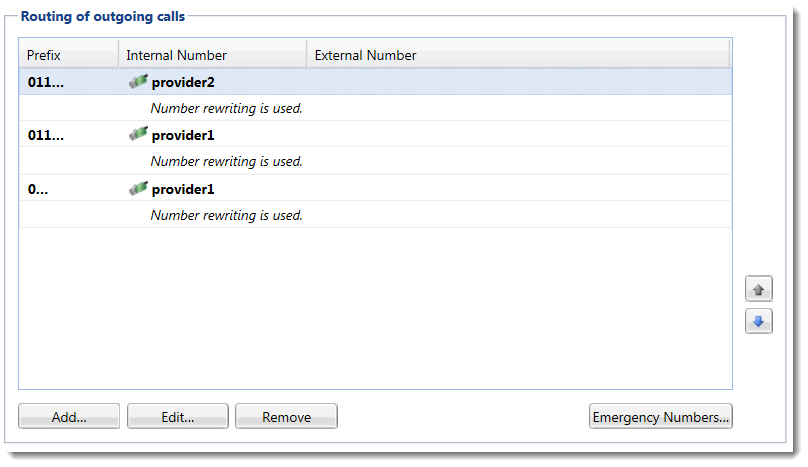
After dialing this number:
- Kerio Operator goes through the Routing of outgoing calls table and tries to match the prefix.
- Kerio Operator finds two matching prefixes, 0 and 011, and uses the longest prefix.
- Kerio Operator tries the 011 prefix to connect to provider2.
- If the connection does not work, Kerio Operator uses the same prefix to connect to provider1.
- If the connection still does not work, Kerio Operator does not try to use the last prefix (in this example, the 0 prefix), and the call fails.
Changing the order of prefixes
Kerio Operator works with providers for the same prefix in order from top to bottom. You can change that order by the using arrows on the right side of the administration interface to move it up or down.
